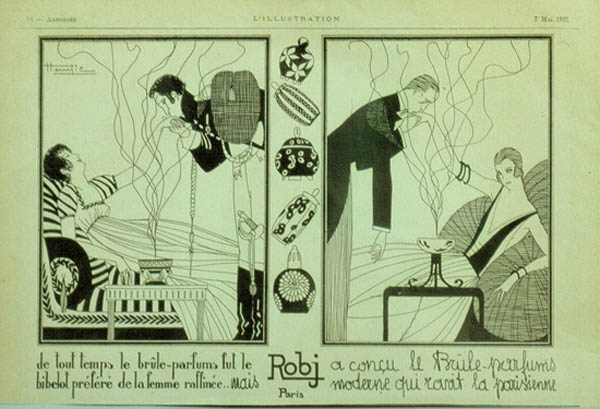Scent Of Mystery: The Allure of The Perfume Lamp
Smack Dab In The Middle: Design Trends Of The Mid-20th Century
Take Theda Bara. The heavy-lidded, heavy-breathing mantrap led gullible admirers to their doom in such lurid potboilers of the early silent screen as A Fool There Was. (Its signature line, immortalized on title cards: Kiss me, my fool! Its signature scene: Theda, posed wild-eyed over the skeleton of a presumably recent conquest. And this was 1915.)
Rumored to be the descendant of long line of mystic Egyptian princesses, Theda was born, not in the Shadow of the Sphinx, but in the shadow of her fathers Cincinnati tailor shop. As an enterprising teen, Theodosia Goodman headed West, finding that Hollywood offered pleasant career options for a girl willing to let the studio publicity machines, (and makeup and costume departments), do their darnedest.
Theda and her sultry sisterhood (Pola, Vilma, Gloria, et al), plied their onscreen trade throughout the 1920s in boudoirs straight out of a Sultans harem. Each new movie offered ever more sumptuous surroundings, laden with ornate fabric wall hangings, and gilt-bedecked, Oriental-themed furnishings. And, omnipresent throughout, was that staple of early Art Deco décor, the perfume lamp. Offering only minimal illumination (well, after all, how much was needed?), the perfume lamp filled the air with intoxicating fragrance, overpowering any gent clueless enough to step past Thedas threshold. And, just like Theda, the perfume lamps present was much more tantalizing than its past.
Long before wafting out whispers of My Sin and White Shoulders, the perfume lamp (aka fragrance lamp) served a more prosaic purpose. Developed in the 1800s, the original intent was to improve the atmosphere in places that really needed it - specifically, hospitals and mortuaries. The lamps low-temperature catalytic combustion process converted unpleasant odor molecules into more acceptable substances - carbon dioxide and water. Unlike the candle, the perfume lamp was longer-lasting, and, despite its acohol-based fuel, significantly safer to use.
It soon became evident that what worked in an institutional setting could also be a best-seller in the domestic market. In those pre-Glade days, the fragrance lamp kept homes free of pesky pet scents, tobacco haze, and general mustiness. Frenchman Maurice Berger realized that even more sales possibilities would be ignited if perfume was added to the lamp fuel. In 1897, he received a patent on this process, and his firm, Lampe Berger, brought out the first true fragrance lamp.
Utilitarian hospital burners were obviously out-of-place in a home setting. Yet, while decorative, the at-home perfume lamp also needed to perform designated duties:
It had to be impervious to low levels of generated heat.
It had to offer, (once electric bulbs were added to the mix), at least basic illumination.
It had to conceal its inner workings.
It had to include sufficient venting for the aromatic fumes to do their trick.
Filling the bill on all counts? Ceramic.
Although some ceramic perfume lamp designs, (overflowing flower baskets, winsome country maidens), were clearly intended for the living room mantel, others were just as clearly intended for more intimate surroundings - The sort Theda had in mind. Glittering with desirability, the perfume lamp made every woman feel like a queen.
Among the manufacturers hot on the perfume lamp scent: Robj, Aladin, and Etling, each attempting to outdo the other with exotic figural themes. There were Geisha perfume lamps...Sultan and Beloved perfume lamps. . . Scheherezade perfume lamps. With the right mood lighting, even the most banal of bedrooms became a romantic hideaway in the Taj Mahal. And that, of course, was the idea.
Many of Thedas idiosyncrasies, (kohl-lined eyes, heavy-metal wardrobe, a diet said to consist of the blood of venomous snakes), sent shivers up the spine of even the most daringly free-spirited housewife of the Jazz Age. The perfume lamp, however, offered a safer dip into uncharted waters.
Donald-Brian Johnson is the co-author of numerous books on mid-twentieth century design. His latest, Postwar Pop, (with more on perfume lamps), has just been released by Schiffer Publishing, Ltd.. Please address inquiries to: donaldbrian@msn.com
All photos by Leslie Piña.

Donald-Brian Johnson
Donald-Brian Johnson is a nationwide columnist, and the co-author of numerous Schiffer books on design and collectibles. His most recent, "Postwar Pop," is a collection of his columns.














